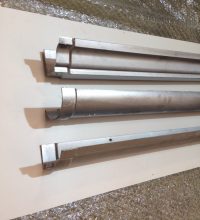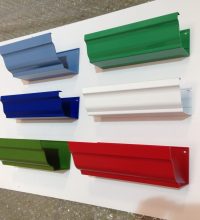Rainwater Downpipes suppliers in Derbyshire
It is necessary that sufficient precautions are taken to ensure that rainwater can be diverted from the roof of a building. We propose that roofs should be designed with surface water collection channels and gutters that carry water, and vertical rainwater donwpipes Derbyshire, that in turn connect the drains that flow into the mixed sewer with the sewer system.
We are the fastest supplier of rainwater downpipes in Derbyshire, which includes accessories such as water diversions to support water quality. Our Rainwater downpipes can be made of cast iron, aluminium and PVC.
Excessive splashing in heavy rain can damage foundations, masonry and mortar if water is not channelled away from the building. The drip must be led sideways to the rainwater downpipe so that the drip runs down the pipe and only drips downwards, where it can be treated with the method described here. Any imagined method must not prevent leaves and dirt from being washed through the pipes, otherwise clogging will occur.
Eavesdropping is a rain-trapping channel that lies parallel or almost parallel to the ground at the edge of the roof. When rainwater is collected through a gutter, it passes through a downpipe or pipe laid in its pipe vertically (almost vertically) to or near the edges of the roof or through a pipe overheard. This component is often installed near or at the end of a perimeter roof to catch the rainwater drain – and remove the water so it does not flood the house.
The rainwater downpipes Derbyshire, flows through the gutter through which the downpipe or pipe passes and is then transported through the pipe to the ground and away from the house.
Knowing the amount of rain on the roof is obviously of crucial importance for the assessment of rainwater discharge capacity. Precipitation has previously been measured in units of mm per hour and is referred to as precipitation intensity. Precipitation intensities of 75 mm / hour are used for the construction, and the higher the intensity, the greater the capacity of the rainwater downpipe.
Guttering and gutters are prone to premature failure due to temperature fluctuations that strain the joint seals or are incorrectly specified, and a leak may require repair of the building. The risk of rainwater runoff pipes failing due to leaks is low compared to other types of pipes, except for those where the risk of rainwater runoff failure is higher than usual, such as in high-rise buildings or buildings with high ceilings.
The size of the building and the requirement for a smooth appearance lead to solutions in which the entire roof drainage is covered by one solution. The accompanying document, the building regulations, gives basic design instructions for the sizes of the gutters.
What are the benefits of Rainwater Downpipes in Derbyshire?
There are clear examples of where there is a risk of failure and the consequences of that failure. In such a situation, failure of part of the roof drainage could lead to water entering the building, which could in turn cause serious damage to the buildings and their existing structure. This could lead to a large number of buildings being unable to be supplied with water in a short period of time, for example during a storm.




